The post Diastasis Recti: What Is It And How Do You Repair It? appeared first on MetaMed.
]]>What is Diastasis Recti?
Diastasis recti is the fancy pants term for abdominal separation. It affects the ‘six-pack muscles' (they are under there!) of your stomach. The anatomical name for your ‘six-pack' is rectus abdominis muscles.
The abdominal muscle separation occurs in both men and women when there is prolonged horizontal stress on the linea alba (line of connective tissue down the middle of your rectus abdominis muscles.
Who Gets Abdominal Separation?
Both women and men can experience a separation of their abdominal muscles. There are a variety of conditions and risk factors that may predispose someone to develop an abdominal separation.

Pregnant Women
Diastasis recti is most commonly seen in pregnant or postpartum women, this is due to the surge of relaxin hormones that help everything to soften. Relaxin allows your ligaments and connective tissue to soften allowing your pelvis to open and accommodate your growing baby and make childbirth easier. It doesn't happen in every pregnancy but this is when we usually see it. It's the common cause of ‘mummy tummy'.
It can happen early in pregnancy or later. It's a good idea to work with a practitioner who commonly works with pregnant women so that they can keep checking if you're starting to develop an abomdinal muscle separation. There are lots of ways you can look after a diastasis to prevent it from getting worse.

Don’t forget the Lads.
Abdominal separation is often missed in men but can contribute to lower back pain. This is why when you come in for back pain we'll look at your whole body to try and work out all the factors you need to address to aid recovery.
We see it lots in farmers and builders. Especially the one with the nice round beer bellies.
Weight gain around the belly area can put extra stress on the abdominal muscles. Pair this with lots of heavy lifting and labor with poor technique over time can lead to separation of the abdominal muscles.
For the men, we often see these many years down the track and it is more challenging to work with, but we can still help. We recommend that if you are in a heavy lifting job that you learn how to use your core properly and take your time with proper lifting technique to prevent it happening in the first place. We recommend seeing a practitioner that understands abdominal separation who can prescribe a specific exercise program that includes core exercises.
For the rest of this article, we'll focus on abdominal separation seen in pregnancy. But guys, get in touch if you think you have this as we can still help you!
How to Detect a Separation
To diagnose diastasis recti a practitioner will feel for a gap between muscles of more than 2cm, further imaging via ultrasound may be used to confirm a diagnosis although not that commonly used.
To test yourself, lie on your back with your knees bent. Supporting your neck with one hand, inhale then exhale and gently lift your neck in an ab crunch like movement. With the other hand, use your fingers to feel in the middle of your abdominal muscles. If your fingers sink in and you feel a gap of more than two fingers, you have a separation.
In more severe cases it may look like doming, bulging, sinking, in the middle of your belly.

What Can Cause It?
It can be hard to tell who exactly is going to get diastasis rectus in pregnancy but there are some things that can make you more likely to develop one.
- Second, third or fourth pregnancy, especially if you had one in a previous pregnancy
- Poor posture of the spine
- Having a weakness of your core control muscles (deep abdominal muscles and pelvic floor)
- Exercising incorrectly during pregnancy
- Lifting excessive loads
What Makes Diastasis Recti Worse?
There is plenty of day to day movements that can make diastasis recti more prominent and prevent healing:
- Sitting up to get out of bed or a chair.
- Getting groceries or strollers in and out of a car.
- Picking up a child.
- Exercises such as plank, sit-ups and squats.
Going back to exercise too quickly post-pregnancy can prevent diastasis repair and can leave you with a ‘pouch’ or ‘mummy tummy' no matter how many crunches you do.
Having an abdominal separation can contribute toward lower back pain, pelvic pain and pelvic floor issues such as incontinence.
If you suspect you have an abdominal separation it's best for you to speak with an experienced practitioner or trainer to learn to modify certain postures, movements and any core exercises or exercise program you do.
Can You Repair Diastasis Recti?
If it gets detected early enough there are definitely ways you can prevent it from getting worse and help restore tension across the separation. This means the gap may still be present but it isn’t so weak anymore. The first six months post-pregnancy is when you have the best chance of improving this.
For pregnant mums, this is where having the right people around you to pick up the signs of diastasis early is important. It may be your midwife, trainer, pilates or yoga teacher, or therapist (Osteo, chiro, physiotherapist).
What Can Help?
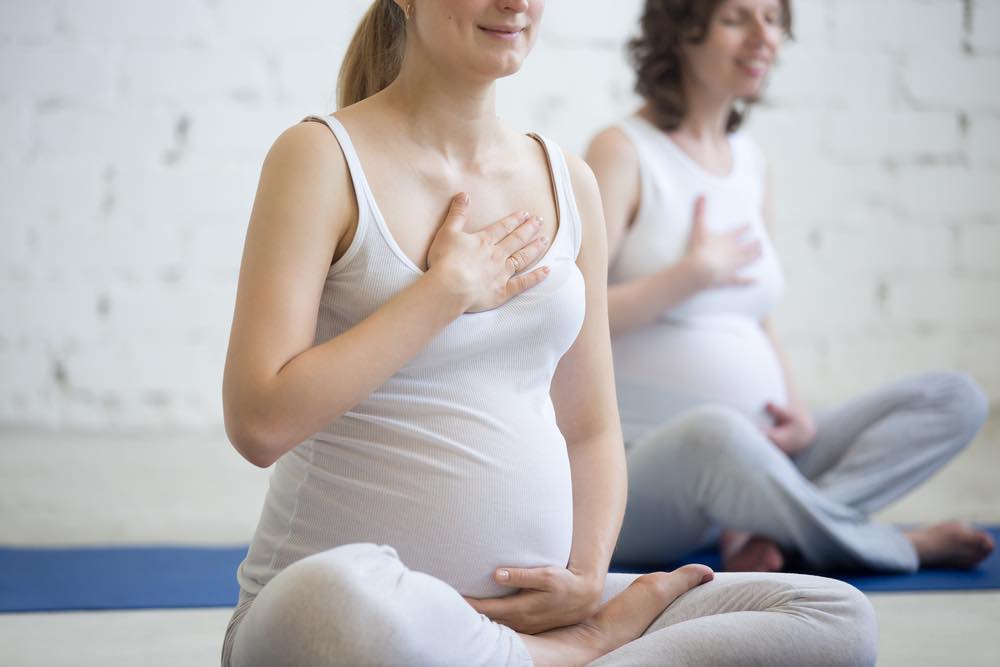
Breathing Properly
The main muscle in-charge of breathing sits underneath the ribcage and is called the diaphragm. Normally, the diaphragm pulls down into the belly, making it rise and fall with each breath. During pregnancy the diaphragm is pushed upwards by the growing uterus and baby, preventing you from getting a full, deep breath.
It’s important to retrain your diaphragm to its full function post-partum as it is an essential part of your core. Spend time each day focusing on ‘belly breathing’ by placing your hands on your lower ribs and expanding them outward, without moving the chest. In for 2 seconds, out for 4-6 seconds. Struggling with this? For more information on breathing click here.
Emma Ferris from The Breath Effect has online classes that can help you out too.

Posture
Postural habits formed during pregnancy commonly continue on post-partum. There are two common postures that require correcting to help repair diastasis recti.
- Some women tend to stand with their pelvis pushed forward, forcing stability to come from muscles in your back and glutes.
- Alternatively, do you ‘hang’ from your hips? Pushing your belly forward and over-extending/locking your knees? This increases pressure on the abdominal muscles and can cause increased curvature of the lower spine ‘sway back'.
Bringing awareness to your posture and focusing on ‘postural stacking’ to align your spine. Try not to arch your back or grip any muscle too tight. Imagine a string is pulling you upright from your head, elongating your midline, spine and stretching your ribcage away from your pelvis.
Avoid Constipation
The act of ‘baring down’ when constipated can significantly increase abdominal pressure and increase abdominal separation. Remember to keep your fluids up, consume plenty (25 grams) of fibre each day and exercise. If this doesn’t work, talk to us about herbal remedies that gently get your bowels moving.
Abdominal Supports
Our friends at Pelvic Solutions, women's health physiotherpists recommend wearing abdominal support shorts (similar to spanx) post-partum to help increase awareness of your abdominal muscles and encourage the muscles to come back together. Ideally, you’d wear the shorts for 6 weeks, however, everyone is different and based on your presentation you might need to wear them for longer. While you’re at it, book in with the team at Pelvic Solutions and get your everything checked!

Non-Aggravating Exercises
There are a few easy to implement changes you can make to prevent ‘belly doming’ in day to day life.
- Avoid sit-up type movements, so roll over to your side in bed and use your arms to push yourself up. This reduces intra-abdominal pressure that may prevent diastasis recti repair.
- When lifting, exhale as you lift rather than gripping on tight. Make sure that load isn't too heavy either.
Pelvic Floor Exercises
Kegels! We all know about them. Pelvic floor exercises can help to strengthen the core as well. But, did you know that many women have an overactive pelvic floor? This means kegel exercises aren't appropriate for you. We recommend seeing a women's health physiottherapist to be assessed and taught how do these exercises properly.
Other abdominal core exercises such as bird dog, heel slides and pelvic tilts can help activate the core muscles without increasing intra-abdominal pressure. Not sure about these? We can help!
AVOID: crunches, planks, squats and any other exercise that increases the pressure in your belly.
Once assessed by a practitioner and given the go-ahead you can start reintroducing ab exercises slowly and gradually.
At-home programs
We also love the MUTU at home post-natal exercise programs which are targeted for a new mum with abdominal separation. They're full of great resources around diastasis recti too.
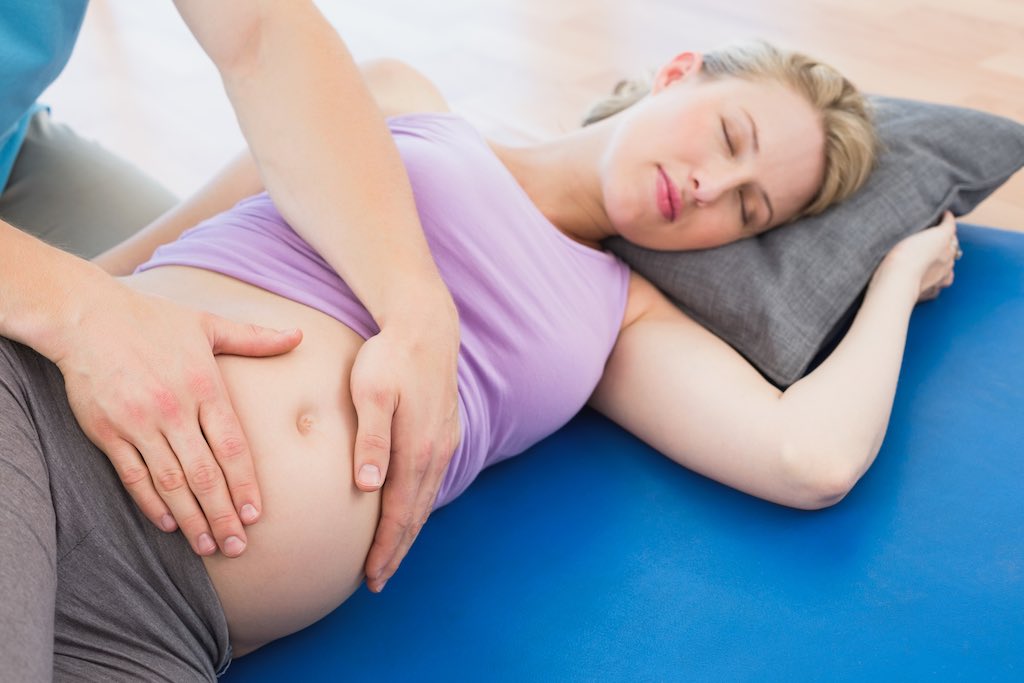
Osteopathy Treatment
Your osteopath can help to diagnose diastasis recti and guide you through the healing stages by advising on the correct breathing habits, postural positions and safe exercises to do. We also love to collaborate with other practitioners and trainers that we know and trust can help you recover and improve your abdominal separation.
As osteopaths we look body wide for compensations in movement patterns and identify any areas that may be contributing to increased pressure on your abdomen. Sometimes you can read all about the issue, but you still need specific and personalised advice to ensure effective healing.
If you are pregnant we also have a great post about what you can do and who you can see at different stages of your pregnancy. Click here to check the post out.

FAQs
Can you fix Diastasis Recti?
Diastasis recti or abdominal muscle separation can be helped.
How do you diagnose Diastasis Recti?
Laying you down, a practitioner will put their fingers over the midline of your stomach (above your belly button). Do a semi sit up. If diastasis recti is present there will be a gap felt greater than one finger wide.
Is Diastasis Recti dangerous?
No. The separation however can get quite large. If a conservative approach doesn’t work (education, postural advice, exercise program and core exercises). This may compromise your ability to stabilise (due to lack of core) and put you at a higher risk of lower back issues. If it is severe you may need a referral to a specialist.
Can Diastasis Recti be painful?
Some people can notice tenderness around the separation particularly around the belly button. More so if there is a hernia present.
What exercises not to do with Diastasis Recti?
You are best to avoid any exercises or movements that cause bulging of the separation or put more stress on the separation. You are best to avoid sit ups or lifting heavy loads.
How do you sleep with Diastasis Recti?
Any position that is comfortable is safe to sleep with an abdominal separation. Just make sure that when you get up from laying to sitting don’t sit straight up. Roll onto your side and use your hands to push yourself up.
The post Diastasis Recti: What Is It And How Do You Repair It? appeared first on MetaMed.
]]>The post Natural Pregnancy Therapies For New Zealand Mothers-To-Be appeared first on MetaMed.
]]>
It can be an exciting and unsettling time for some, you may have planned your birth, or not! But it’s pretty amazing that we can grow another human inside of us without much thinking!
There’s usually lots of new information coming your way from friends, parents,
First Trimester
As osteopaths and chiropractors experienced in treating during pregnancy, we are happy to treat you before, during (anytime) and after pregnancy. Most people are told to avoid treatment during the first trimester but we are happy to continue as long as you are. It’s a good idea to continue treatment especially if you’ve had a pre-existing issue that hasn’t yet resolved. We normally stay away from
If you haven’t had any prior musculoskeletal issues it’s still a good idea to have a full assessment and check that everything is functioning and working as it should. We’re big on identifying weaknesses and addressing them before they become a problem.
During
Here
Basic Stability Exercises:
These can be done in the first trimester whilst you can still comfortably lay face down. Click on the link below the image to download your exercises.
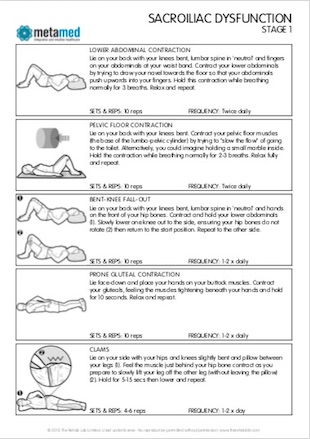
Download your exercises here:
LEARN HOW TO SQUEEZE YOUR GLUTEALS (SACROILIAC STAGE 1)
Second Trimester
If anything we notice that if you’re going to have any niggles they tend to come on around the 22-week mark, earlier if you have had pre-existing issues (although don’t worry this isn’t always the case). Our aim is to keep you comfortable and moving well throughout your pregnancy. It doesn’t have to be uncomfortable! (read our article from little treasures on supporting you through pregnancy)
If things are ticking along well this is what we check for:
- Gluteal activation and strength
- Hip girdle stability to prevent sacroiliac instability (that sharp catching pain in your bum) and pubic symphysitis (pain around the pubic bone)
- Maintain good thoracic and rib mobility to allow your baby to expand into space under your ribs
- Assist with reflux and heartburn by releasing through your mid-back and diaphragm
- Advise you around postural changes and movement changes that can benefit you for when you grow a bit more and once you have your baby
- Avoiding stress through your abdominals
- Supporting your body for optimal baby positioning
In the early stages if we can get you into a good routine and awareness of gluteal activation you’ll be much better off and safer when you start something like regular pregnancy pilates and/or yoga. The most common issue we see is pelvic girdle and low back pain.
Next Stage Hip Stabilisation Exercises:
If you have good gluteal activation here is the second set of exercise you can continue with. Click on the link below the image to download your exercises.
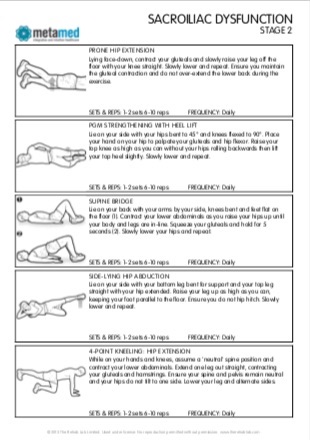
Download your exercises here:
PROGRESS YOUR GLUTEAL ACTIVATION AND HIP GIRDLE STABILITY (SACROILIAC STAGE 2)
Third Trimester
From around 30 weeks. This is when your baby really starts to grow, your belly gets bigger, your breasts may increase in size. And sometimes your body may not be able to adapt to the changes so easily. Heartburn or reflux may come on too.
We use a pregnancy pillow so that you can enjoy laying face down for your treatment.
Other Recommendations:

Acupuncture
Acupuncture can help throughout all stages of pregnancy. Early on for morning sickness and threatened miscarriage. And, throughout pregnancy for fluid issues, congestion, back and hip issues, sleep stress and mental health.
From around 33 weeks if your baby is not head down we recommend seeking Traditional Chinese Medicine (TCM) acupuncture. Which has shown to be effective in ‘turning’
At 36 weeks we also recommend you book yourself in with a TCM acupuncturist who does a protocol of treatment known as ‘cervical ripening’. Acupuncture needles are applied to specific areas to assist the body to prepare for birth. If your baby is hanging around a little longer than strong induction techniques can be used.
Wanaka: The Acupuncture Room and Mike Carter at Acubalance.
Queenstown: Daisuke
Acupressure booklet:
We also recommend Deborah Betts – Midwife & Acupuncturist ACUPRESSURE BOOKLET which gives handy tips on points to use throughout pregnancy and during labour.

Pregnancy Pilates and or Yoga
Pregnancy
Pregnancy yoga is also great, but again you want a teacher who is mindful of your stability.
Wanaka: The Body Garage for pregnancy pilates and yoga or Yoga Ground for pregnancy yoga. You can also do reformer pilates with physiotherapists and
Queenstown: Nadi Wellness for pregnancy yoga and Equilibrium space for 1:1 reformer pilates with Emily Waterhouse. Back on Track Physiotherapy offer space in their beginner
Hypnobirthing
We’re so lucky to have hypnobirthing services in Wanaka and Queenstown. Courses are run by Roz McRae from Lakes Hypnobirthing. This is a positive and supportive environment that actively involves your partner to be a great support during the birth. It’s not just for people wanting homebirths. Anyone can do it whether you’re going to a birthing
We recommend getting onto Roz sooner rather than later to find out when she runs courses. Roz recommends starting at 20 weeks so you have time to practice the technique and
You’ll get the Hypnobirthing book by Marie Mongan with the course, but if you want to read it first- here’s a link to the book. https://bit.ly/2WQItgw
Pelvic Floor Physiotherapist
We also highly recommend seeing a pelvic floor Physio. If you’re close to Wanaka we
Lisa Carnie and her team recommend you book in for a check at 30 weeks, 36 and 38 weeks and find that pregnant women they see have much better birth outcomes. It’s an opportunity to discuss any fears, the ins and outs of birth and recovery.
They assess your pelvic floor function especially for any muscle overactivity or tension that may lead to increased risk of perineal or pelvic floor injury during birth. Internal releases can help decrease muscle tension making for an easier vaginal birth. They also ensure:
- your muscles are strong in prep for birth
- check your breathing to aid the birthing process
- posture
- assess and advise on abdominal muscle separation prevention (diastasis rectus abdominis)
They then love to support you during the post-natal period for recovery and ensuring your pelvic floor returns to full and healthy function. You can go in as early as you want but generally internal examinations are not done until 6 weeks post-natal.
Wanaka: The team at Pelvic Solutions
Queenstown: The team at Pelvic Solutions currently visiting once a month

Herbs in Pregnancy
We hand blend a range of herbal tinctures to assist during the later stages of pregnancy, birth and post-natal period.
- Pregnancy Tea Tincture
- Labour Prep
- Placenta Release
- Bleed Stop
- Mastitis Relief
- Milk Flow
To learn more about each of the herbs available in our pregnancy kit please click here for a video explanation.
Post-Natal Period
Giving birth is one day and now there are so many days to learn how to be a mum, integrate into a family.
You'll normally have support from your midwife the first 6 weeks. But, often the questions keeps rolling in after this period. You can seek support from many other health practitioners. It's important that you don't let anxieties build up during this period.
There are a range of herbs that can support you during pregnancy if you get sick as well as during the post-natal period.
It is strongly recommended that you seek advice from a Naturopath or Herbalist to check if it is safe to take certain supplements and herbs during pregnany. We can put you in touch with a Naturopath or we have a herbalist (Jin Ong) at our clinic who can advise you.
Some herbs we recommend during the post-natal period that not alot of people know about!
Mastitis Prevention and Treatment
Poke root for mastitis prevention and relief. Used historically in pregnancy and lactation and extremely effective. We recommend that you get hold of this in the weeks leading up to having your baby as when mastitis takes hold it’s pretty rapid. So great to have on hand to start taking once your breastmilk starts flowing. 25ml will last you 6-9 months. You must consult a herbalist or naturopath to dispense this. You can contact [email protected] to get in touch with one. Or this is part of our pregnancy kit herbs as above.
Increase Breastmilk Supply
Fennel, Fenugreek & Goats Rue to help increase milk supply. A 50ml bottle will suffice and normally takes three days to kick in. Also part of our pregnancy kit or can be bought individually.
Supplements:
- BioCeuticals Ultrabiotic Pregnancy Care- a high
bifidum bacteria content to help your babies gut health as it will pass through breastmilk. This is great to take if you've had to take antibiotics at the end of your pregnancy, experiencing mastitis or vaginal thrush.
Post-Natal Exercise
Time after having your baby is an important time to rest and recover, sleep, nurture and nourish yourself. Hormones and body fat are also important for good breastmilk supply. Relaxin is still in your body so joints may still be lax.
If you experienced an abdominal muscle separation (diastasis) during your pregnancy the first six months are an important time to get your muscles to come back together. Strong and heavy, inappropriate
Pelvic floor health is also important to consider, to be able to engage correctly before getting back into exercise. It is best to have this checked by a pelvic floor physiotherapist.
Ensure you work with a personal trainer who is familiar with
Pregnancy Pilates classes are often a good option. Look for classes by physiotherapists or pilates studios that offer specialized pregnancy and post-natal classes. There are usually some great mums and bubs classes where you can take your little one with you.
Home Exercise Option
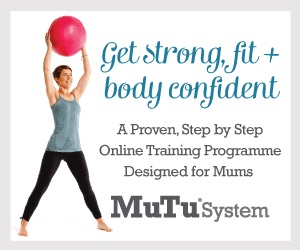
MUTU is a great home program option, targeted at post-natal exercise and full of great information. It is still a good idea to get the OK after you have had your pelvic floor and abdominal muscles checked.

Some Other Book recommendations
Gentle Birth, Gentle Mothering by Dr. Sarah J Buckley an Australian based GP this book pools on different research and articles around the world and discusses different modes of birth https://bit.ly/2GvFSCN
Inna May Gaskin’s
Timeline Mapped Out
In towns like Wanaka and Queenstown practitioners are busy, so we recommend you follow the timeline and look into contacting providers earlier rather than later.
0 – 12 weeks
Osteopathic or chiropractic treatment. Assess and teach gluteal activation, core and hip girdle stability basics.
TCM Acupuncture can also help during this time for morning sickness, nausea and threatened miscarriage.
12 – 22 weeks
Continue monthly treatments. We notice around 22 weeks is when issues arise if they’re going to. During this time we can progress your exercises.
Consider starting Pregnancy pilates
Contact hypnobirthing provider to book in a course towards the end of your second trimester.
Contact pelvic floor physiotherapist to book in your
28 weeks
Start hypnobirthing course
30 weeks
Baby starts growing quicker. If needed treatments can be brought down to fortnightly especially if
Book yourself in to see a pelvic floor physio for pelvic floor function assessment.
33 weeks
If your baby is not head down this is a great time to start seeing a TCM acupuncturist – please ask us for contact details. This is also a good time to book yourself in for 36 weeks for ‘cervical ripening’ treatment with a TCM acupuncturist.
36 week
Book yourself in with a TCM acupuncturist for ‘cervical ripening’ to help prep your mind and body for birth. Generally 4 treatments one week apart that will continue if your baby decides to stick around
Follow up with pelvic floor physio.
38 weeks
Follow up with pelvic floor physio.
Post-natal herbs- especially mastitis relief and
40 weeks
You can consider induction acupuncture with a TCM
Now and then we hold community events with various professionals around birth and pregnancy, a supportive and positive environment. If you’d like to be notified of when these are happening please email us.
The post Natural Pregnancy Therapies For New Zealand Mothers-To-Be appeared first on MetaMed.
]]>